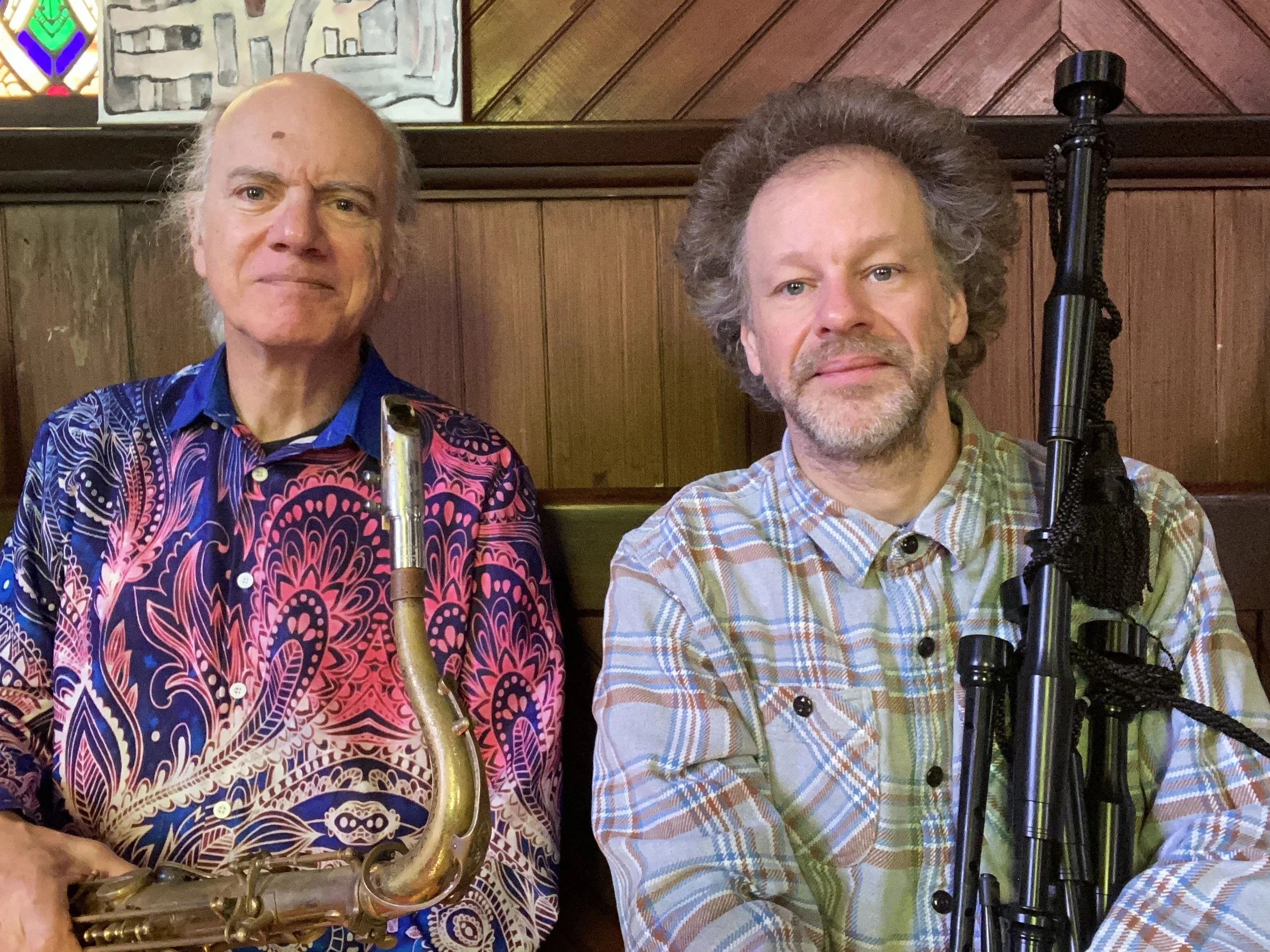EUDIMORPHODON
EUDIMORPHODON, is an early pterosaur AND a new duo with Dan Plonsey (saxophones) and Matthew Welch (bagpipes). Featuring compositions and improvisations by both for this unique combination of reeds, Plonsey and Welch dig deep into their love for odd creatures and characters to summon forth wild sonic beasts of imagination.
The EUDIMORPHODON “studies” are pieces that bring compositional form to a system of dimorphic harmony, a term I use that bridges bitonality and hexachordal harmony, designed to mold pitch structure that facilitates the old, modal bagpipes (principal line) into a new, chromatic instrumental world. Their titles pull from early pterosaurs (and their skeletal musical ideas). Think of them as extinct fossils to reanimate. Performing with Dan, one of my creative music heroes, has been a dream come true! Sharing two mentors, Martin Bresnick and Anthony Braxton, no wonder our music came together so well! - Matthew Welch
The pterosaurs were not, in fact, ancestors of modern birds -- dinosaurs were: in particular, the T. Rex and velociraptor. But that is neither here nor there. The role of birds and birdsong in the development of modern music cannot be overstated. Obviously the song: the irregular, jagged rhythms; the microtonal variations in pitch; the composite melodies of flocks e.g., of blackbirds at sunset. The music that Matt and I make is -- out of the four elements -- of the air. In "Naturally, the Egg" we play a modal melody twice, first in canon, and later, after improvisation, in a loose heterophonic unison, like a flock of two. The song of the soaring, swooping Eudimorphodon could not have been more eery and thrilling than that of bagpipes and saxophone together. - Dan Plonsey
Artwork for EUDIMORPHODON by Jonathan Johansen
“as thrillingly primordial as the extinct pterosaur that gives the project its name”
“Eudimorphodon is pretty magical…It’s spiritual, scientific, metaphorical, old, and new, and it cleans out your pipes. Five stars”
Reviews
The Wire
August, 2025
by Stewart Smith
Matthew Welch and Dan Plonsey
EUDIPORPHODON (Kotekan CD/DL)
A leading figure in experimental bagpipes, Matthew Welch combines a mastery of Scottish pibroch with elements of jazz and new music. On EUDIMORPHODON, he teams up with fellow Braxton associate Dan Plonsey for a series of bagpipes and saxophone duets that are as thrillingly primordial as the extinct pterosaur that gives the project its name. As Welch explains in the sleevenotes, his aim is to “bring the old, modal bagpipes into a new chromatic instrumental world.” We hear that in the opening “Naturally, the Egg,” where he and Plonsey play a modal melody in canon, before breaking into woozy pitch bends and swooping caws, carried by intense Tony Conrad-like drones.
The Free Jazz Collective
June 14, 2025
By Gary Chapin
You may not often think of bagpipes in free jazz improv, but if you do, it’s a good idea to think of them in terms of behemothic, pre-avian termagants stomping through the primordial wetlands— unearthly ferns growing up to their shoulders, a wet-heat, high O2 atmosphere guaranteed to provoke an altered state—and that’s what piper Matthew Welch and sax guy Dan Plonsey do on this recording.
The pipes/jazz disconnect comes from the fact that pipes are a very traditional and regimented (really, there are pipe regiments) and, if played correctly are pretty dang diatonic, with only an octave +1 in its range and the two drones (a 1 and two 5s) slamming you into the tonic center. Here’s the thing, ideally there is but one way to play the pipes correctly, but Welch (and a few others) have discovered that there are an unlimited number of ways to not play correctly. Just like with a target: a limited number of ways to hit, an unlimited number of ways to miss—but when you miss the target, you're still going to hit something, and the something on Eudimorphodon is pretty magical.
Welch and Plonsey paint in jagged, vibrant, microtonal, loud, blunt, articulate smears, evoking the flying monsters of the pre-human world. Eudimorphodon is an early pteranodon, as are the other creatures namechecked in the set list. These are thematic and vibe cues to the music, synaesthetic comp and improv prompts that—when you hear the music—make all kinds of sense. Making sense doesn’t make it less unnerving, though. There’s something about the sheer quantity of sound the pipes produce—as many limits as the instrument has, only 9 pitches and three drones (supposedly), but when you stand next to a piper playing it’s infinite, transcendent. Like a strong river pushing at you, functionally never ending—just like those drones. And speaking of the drones, they may in some contexts, lock you into a tonal center, but the way Welsh plays, they create almost geological anchors with which all of the microtonal possibilities create unique relationships.
Fiercely interesting stuff. As Plonsey writes in his remarks, “The song of the soaring, swooping Eudimorphodon could not have been more eerie and thrilling than that of bagpipes and saxophone together.” Honestly, I can’t imagine any set of instruments more suited to, say, Albert Ayler’s aesthetic than these two. It’s spiritual, scientific, metaphorical, old, and new, and it cleans out your pipes. Five stars.


